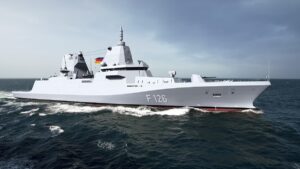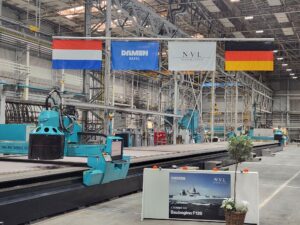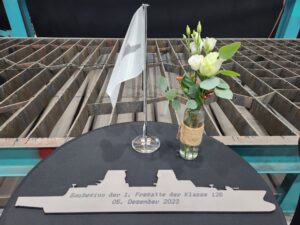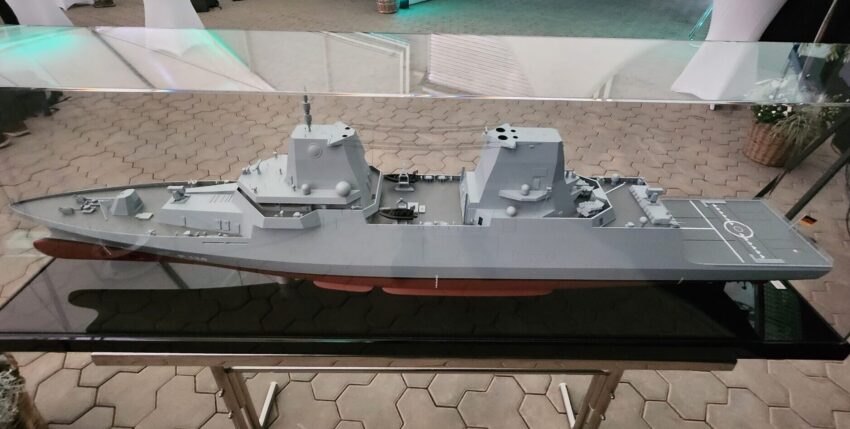The multi-purpose combat ship "MKS 180", which has since been renamed "Frigate F126", saw the start of construction of its first unit on 5 December 2023. Just a few days before the end of the year, the start of production before 2024, which had been promised when the contract was signed, was thus realised.

Lead time
On 19 June 2020, the signatures with which Damen Schelde Naval Shipbuilding (DSNS, Netherlands) and the Federal Office of Bundeswehr Information Technology and In-Service Support (BAAINBw) agreed on the construction of the multi-purpose combat ship "MKS 180" were signed in Koblenz. At that time, 5.72 billion euros were included in the federal budget. For this amount, Germany is procuring four identical frigates, two of them with the "ASW-Lagebild" mission module (ASW: submarine hunting/underwater warfare) and two with the "Gewahrsam" mission module including shore facilities for training as well as the external construction support estimated to last around ten years. This brings the net construction costs for the largest units of the German Navy to 4.824 billion euros according to the current federal budget (government draft for 2024).
The awarding of the contract to a foreign shipyard caused a furore and a bad mood. Damen tried to take the wind out of the sails of this German sentiment by promising to have a high proportion of the order manufactured in Germany. "Together with its German partner Blohm+Voss, DSNS will realise the project in such a way that around 80% of the total investment will remain in Germany as added value," the Dutch shipbuilder announced. In addition, it is said to have been contractually agreed that around 30 per cent of the volume will be awarded to medium-sized companies.

Shipbuilding
As a result, the F126 frigate is being built in co-operation between the Dutch Damen Group, the Thales Group and the Lürssen Group with the involvement of German Naval Yards. In other words, at shipyards in Wolgast, Kiel and Hamburg. According to the current project plan, the Peenewerft shipyard, which belongs to Lürssen, will build the aft ships, while German Naval Yards will build the foreships. The Kiel-based company will be responsible for the assembly, the so-called marriage joint. The final outfitting is to take place in Hamburg at Blohm und Voss.
We will be able to see whether this enormous coordination task will really succeed. The current schedule envisages the commissioning of ship 1 on 16 June 2028. Ship 2 on 15 March 2030, ship 3 on 14 February 2031 and ship 4 on 17 December 2031.
Conceptually, there is a need for six F126 units. In the Marine 2035 course originally published as a target vision, the inspector of the navy justifies this with the need to have two units ready for deployment after maintenance and deployment preparation. The construction contract now provides for the procurement of four units. With a contractually anchored option for two further units, the conceptual requirement could be covered. The option can be exercised until June 2024 (source: 17th Armaments Report of the BMVg, June 2023). The hope that this option would be honoured quickly in connection with the Bundeswehr Special Fund (March 2022) was dampened shortly afterwards and has since been blown away by the Constitutional Court ruling at the latest.

No battleship
The ministerial procurement lyric reads:
The F126 class frigates will be capable of global deployment across the entire intensity spectrum for three-dimensional naval warfare. The most important tasks include maritime surveillance, enforcing an embargo, supporting special forces and evacuation operations.
This broad range of tasks is to be supported by the fitting of special mission modules - a first for the German Navy. Mission modularity refers to the ability to adapt a ship for specific missions using standardised equipment and personnel packages. Special mission modules and on-board mission components are brought on board for this purpose. The operational requirements for the F126 include the following mission modules:
- Mission module ASW situation picture (Anti Submarine Warfare) with a towed sonar to create the underwater situation picture,
- Detention mission module for the temporary detention of persons,
- MCM (Mine Counter Measures) mission module for combating underwater warfare agents (sea mines),
- Mission module diving pressure chamber to support diving operations.
The mission modules, which are designed as standard containers, can be transported anywhere in the world and scaffolded wherever appropriate ship loading facilities for containers are available.
For the licence plates of the frigate F 126 see under
https://esut.de/2022/06/fachbeitraege/34345/fregatte-klasse-126-auf-kurs/

A word about ladies
The family-run company based in Gorinchem operates 36 shipyards and repair yards worldwide and employs 13,000 people. In addition to naval units, the portfolio includes tugs, workboats, coastguard units, high-speed boats, cargo ships, dredgers, ships for the offshore industry, ferries, pontoons and luxury yachts. Over 6,500 ships have been delivered to more than 100 countries.
++++++++++++++










